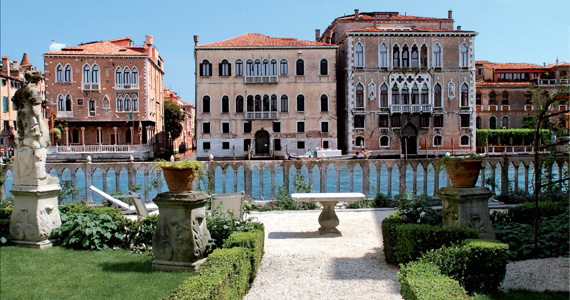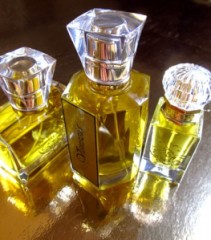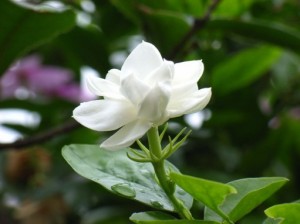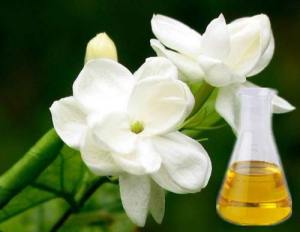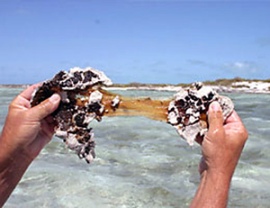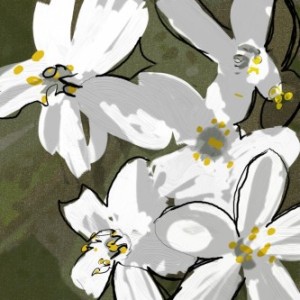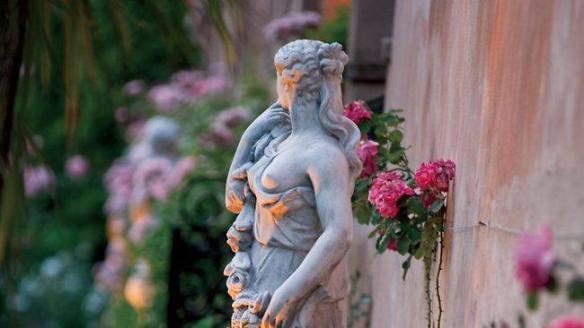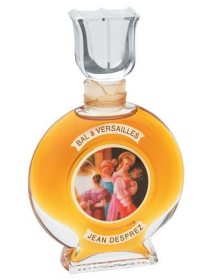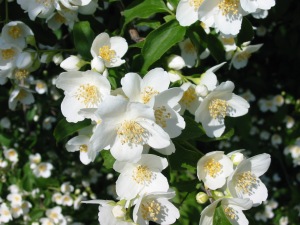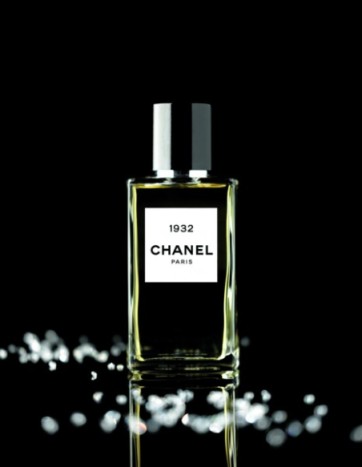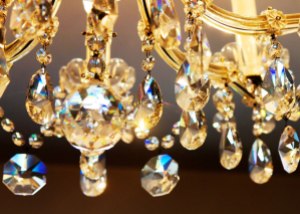Juxtaposed contradictions that tease you with masculinity and femininity, gourmand sweetness and desert aridity, lightness and dark. Feminine florals with swaggering machismo. Janus with two faces in one. Two different fragrances that lie side-by-side, or almost on top of each other like an optical illusion. I would say that all of those things are the essence of Opus VIII, except this is a fragrance that is quite a shape-shifter and you never know quite know what you’re going to get. At the end of the day, the latest creation from Amouage is a scent that is so prismatic, it throws out different notes like light hitting crystal. I think it is rather genius.
Opus VIII is a brand new eau de parfum that is part of Amouage’s Library Collection. Perfumers Pierre Negrin and Richard Herpin worked under the direction of Christopher Chong to create a scent that is expressly meant to be an olfactory version of a Trompe l’Oeil, which an optical illusion involving layers that expand space and depth.
According to the official Amouage press release quoted by Fragrantica, there were other goals in mind, too:
Amouage Creative Director, Christopher Chong, masterfully composed the fragrance to linger amongst the parallels of truth and perception. Crafted with the perfume connoisseur in mind, irrespective of age or gender, the woody, floral fragrance comprises of the finest ingredients sourced from around the world. Jasmine Sambac from India serenely fuses with Ylang Ylang from the Comoros and Orange Flower from Morocco to reveal a golden aura in the top notes. Saffron, Ginger and Incense smoke in the contradictory heart conjures an abstract and intriguing profundity. A surreal wave of luxury passes through the structure of the fragrance with the dark intensity of Benzoin, Balsam, Bay and Vetiver.”
According to that press release, the notes in Opus VIII include:
Top: Jasmine, Ylang Ylang, Orange Flower.
Heart: Frankincense, Saffron, Ginger, Vetiver, Gaiac Wood.
Base: Balsam, Benzoin, Jamaican Bay.
I’d like to take a brief moment to explain “Jamaican Bay,” a note which Fragrantica also calls West Indian Bay in its official entry for Opus VIII. According to my digging on Google, West Indian Bay is Pimenta racemosa or Pimenta berry, a tree in the Myrtle family. Its aroma is said to be”rich and pungent” with “hints of allspice, menthol and cinnamon.” Another site states that the “fragrant oil superficially resembles clove oil, another tree in the myrtle family.” In short, don’t be misled by the term “Jamaican Bay” into thinking that Opus VIII smells like Jamaican Bay Rum, or any rum for that matter. By the same token, don’t confuse the association with the myrtle family or with bay leaves to think that the note in Opus VIII will smell like any of typical Mediterranean varieties of those ingredients.
It’s extremely difficult for me to know where to begin in discussing how Opus VIII manifests itself on my skin. The simple reason is the prismatic nature of the scent that I referenced up above. I’ve tested the fragrance about 5 times by now, using different quantities, and no two tests are completely alike. Opus VIII is a shape-shifter, throwing out different notes each time. The most noticeable thing is just how critical quantity seems to be. Depending on how much you apply, the notes manifest themselves quite differently in terms of prominence, potency, and order. Sometimes, you get entirely new elements, or things that are not even included on the list. As a whole, Opus VIII is a bit like entering into a house of mirrors, where you never know what is going to reflect back at you.
The only common thread between all my tests is that Opus VIII is a woody floral centered around jasmine that reflects utterly contradictory facets, usually all at the same time. The rest… well, it all depends. So, I’ll start with one of the versions of Opus VIII on my skin, and intersperse observations throughout about the other tests and their differences. I hope you’ll be patient with me, because this is quite a complicated fragrance once you look past the ostensibly simple veneer of a “jasmine woody musk.”
Opus VIII opens on my skin with ginger dusted white flowers, an incredibly desiccated aroma-chemical, a slightly herbal nuance that is green in nature, and the bewildering presence of a citrus note. I have no explanation for the latter, but on a number of occasions while wearing of Opus VIII, I smelled various degrees of bergamot, lemon custard, lemon meringue, and even, at one point, a sort of Key Lime pie aroma. There is absolutely nothing listed in the official notes about anything citric in Opus VIII, so I rather feel like a crazy person, but that’s what I detect. As you will soon see, it won’t be the first time that Opus VIII makes me feel as though I were imagining things….
Nonetheless, the driving force behind Opus VIII on my skin is, and always will be, the white flowers. In the first few seconds, they are an abstract, amorphous accord without any distinct shape or delineation, creating merely the impression of something light, airy, and utterly translucent. That quickly changes and, within moments, they morph into orange blossoms coated with jasmine sweetness. Saffron is lightly sprinkled on top like red pollen, right next to the ginger.
The odd thing, though, is another spice accord. It’s like the strangest combination of something almost like cardamom with a hint of dry dustiness that almost resembles cocoa, only not quite for either one. It doesn’t smell like All-Spice, which is something I’m extremely familiar with and use in cooking. Still, it has to be the “allspice” character of the Jamaican Bay that has perhaps been altered by the saffron to become sweeter in nature.
The flowers fascinate me. They feel like a set of contradictions lying side by side: Janus white and black; a swaggering, macho, dusty aridity next to syrupy, feminine sweetness; and, most of all, an aloof coolness countering rich warmth. Those flowers are definitely distant, remote, and cool in their gauzy, billowing translucency. And, yet, they lie on a base of sweet warmth. It’s like Julius Caesar versus Cleopatra, with a touch of the cozy sweetness of a warm kitchen.
Yes, I said “kitchen.” There is a buttery undertone to that dusty, fiery saffron that lends itself to the unexpected impression of sweetened, lightly floured bread. (I did mention that Opus VIII sometimes made me feel like a crazy person, right?) Perhaps it is the vanilla which lurks in the base, mixed with the dustiness of the Jamaican Bay and saffron. Or, perhaps, it’s one of those elements in conjunction with the guaiac wood. Whatever the source, there is almost a wheaty, warm baked bread undertone to Opus VIII’s floral top layer, and it appeared in two different tests.
10 minutes in, Opus VIII’s bouquet turns richer and sweeter. The orange blossoms bloom, releasing a narcotic headiness that is surprisingly weightless in feel. They have a rich depth, but the flowers never evoke heated, warm, heaving flesh or languid courtesans seeking to seduce. Frankly, there is too much of a masculine edge to them, undoubtedly from the aromachemical in the base with its desiccated, parched nature. The latter helps to keep the orange blossoms’ indolic nature firmly in check, at least at first. In the opening stage, there are no rubbery, mentholated, minty, black, or skanky facets to the flowers. Yet, they are not green either, for the growing prominence of the jasmine lends a definite sweetness to Opus VIII’s bouquet. The whole thing feels like a very carefully planned balancing act.
Nonetheless, Opus VIII has a noticeable tinge of greenness lurking at its edges. This time around, the note has an aromatic touch that felt simultaneously woody, leafy, a bit herbal, and almost like a distant cousin to eucalyptus. It’s a lovely touch that is complemented by the bergamot nuance wafting about in the background. (I know, I know, none of these things are listed in the notes! Believe me, I find it as strange as you probably do.)
However, on another occasion, the green note was a completely different story. Call me insane, but I smelled green honeydew melon with a touch of cucumbers. There was a watery liquidity that didn’t smell precisely aquatic, but it was definitely a streak of green. Calone? I don’t know. I suspect Melonal much more, or some version of a green melon synthetic.
Opus VIII was well on its way to making me question my sanity (and my nose). Then, on one of the occasions when I wore it, I asked someone to give my arm a sniff. They immediately said “cucumber!” Not jasmine, not orange blossom (which is what I myself was detecting as the primary note at the time), but “cucumber.” It was their immediate first impression. I rather wish I could have given them my arm to sniff on the occasion when I was wafting warm, wheaty, floured bread.
Whatever the particular oddities of the green and/or liquidy note, Opus VIII’s opening always involves some form of strong vanilla custard on my skin. I think I read somewhere that Opus VIII’s gourmand notes are meant to turn up at the end of the perfume’s development, but not on me. In the main test that I’m writing about, the vanilla starts its rise to the surface after about 20 minutes. On other occasions, the perfume began to waft a vanilla custard, lemon custard, or lemon meringue note much sooner. In all the cases, the vanilla is rich, smooth, deep, and, at the same time, airy and sheer. In this main test, it combines with the saffron, Jamaican Bay, that bread impression, and the slowly weakening ginger element to create something akin to ginger shortbread.
All of this is happening side-by-side with the orange blossoms coated with jasmine syrup. These polar opposites abound simultaneously in Opus VIII, almost as if the perfume had split down the middle with the two faces of Janus facing each other in the mirror. Two shapes, a masculine and a feminine side, growing out of the same core. Yet, Opus VIII never feels schizophrenic. For one thing, both halves are blended beautifully into a single whole. More importantly, Opus VIII feels very prismatic, reflecting different facets at different times, like light refracting off a crystal throughout the day.
Which brings me back, again, to my other tests of Opus VIII. The very first time I wore the scent, I only applied a small quantity, a single spray which would be the equivalent of 2 small smears from a vial. On that occasion, I was greeted by a rather alarming aromachemical note of great desiccation. It was forceful, and left a tickle in the back of my throat. The physical reaction may have been minor, but the opening salvo was strong enough to be far from my personal cup of tea.
Even when the gauzy jasmine unfolded and delicately merged with the vanilla, that synthetic twang remained. It was a very dusty, parched figure which sapped a lot of the warmth and depth from the scent. In fact, the flowers in Opus VIII on that occasion felt a little like a tiny oasis amidst a vast desert wasteland. The perfume did improve, and the notes ended up in greater harmony, but I was still unenthused. For the most part, Opus VIII felt merely like white florals thoroughly imbued with a very arid aromachemical, atop an abstract woody base that was just barely flecked by something vaguely ambered.
For my second test of Opus VIII, I applied a greater quantity, and the result was fundamentally different. Sharply so, in fact. I used 2 big sprays from the decant, amounting to 3 good smears from a vial, or a little over 1/4 of a 1 ml. And Opus VIII bloomed. The horrid desiccation was subsumed in a richer, deeper mix. In fact, it was merely a light vein streaking through the base, and hardly a significant player in the bouquet as a whole. I actually noticed the exact same situation with Slumberhouse‘s new Zahd, where a greater quantity hid the arid Trisamber aromachemical.

“Static – Window to the Soul (Jasmine)” (Detail) 2013, by Tom Jackson and Craig Evans. Source: Wall Street International Magazine.
Here, too, the parched, dusty element is immediately integrated into the rest of the fragrance if you double the dose. The aroma-chemical (which I suspect is of some ambered variety) reveals itself at brief intervals in a sharp, individual manner, but, for the most part, it merely works indirectly from the sidelines to keep the sweeter elements in balance. It also adds to that masculine edge in Opus VIII, and gives the jasmine its swaggering attitude. A friend of mine, Carlos, may actually have the very best description I’ve ever seen for the very unusual character of the florals that ensues. If I remember correctly, he called it “jasmine with an erection,” and, honestly, that blunt categorization is completely accurate. It also supports the duality or polarity of Opus VIII.
In my third, fourth, and fifth tests of Opus VIII, I tripled the quantity to 3 big sprays, amounting to over 1/3 of a 1 ml vial, and the result was even greater richness and depth, with additional, further reduction of the aromachemical note. The orange blossom showed up in two of those tests, which hadn’t happened previously, as did the ylang-ylang. Once, there was a distinct herbal undertone in the first two hours as well, almost as if there were a real myrtle tree with its distinct aromatic kinship to eucalyptus. The saffron popped up at the higher dose, too. In contrast, the ginger did not always appear, at least not in a strongly prominent manner. There were other variations each time, too, like the cucumber, melon, lemon meringue, and bread undertones, but at no time was the aromachemical dryness a problem the way it was at the smallest dose.
In short, if or when you try Opus VIII, please try to keep in mind that the quantity you use might be very critical. Spraying a small amount may amplify different elements or create a different version of the scent. In addition, since aerosolisation increases a fragrance’s potency, if you’re dabbing from a vial, you may want to keep this words even more in mind, and apply a greater amount than what you would normally use.
I’m bringing up all these differences now, as opposed to the end of the review, because Opus VIII’s greatest changes usually occur in the first few hours, no matter how much of the perfume you apply. It’s the opening phase which is the most prismatic and complex on my skin, not so much the rest which can sometimes be quite linear for hours on end.

“Phantasms of the Living” (Detail) 2013, by Tom Jackson and Craig Evans. Source: Wall Street International Magazine.
In my main test that I’m writing about, one of the loveliest parts of Opus VIII occurs about 45 minutes into its development. The jasmine emerges fully from behind the white veil of orange blossoms. It’s incredibly silky, creamy, and smooth. There is a black heart to the flowers, but the dirty, indolic core is — like everything else in Opus VIII — firmly balanced. Tiny veins of a leathery darkness begin to streak through the flowers, gradually connecting the jasmine to the orange blossoms. Slightly smoky nuances appear, along with a small pop of mentholated rubberiness that so typical to very indolic flowers. Neither aspect is overpowering, and they certainly don’t distract from the growing creaminess of the floral bouquet.
The creaminess is helped by other shifts in the scent. The ginger and saffron sink into the base. Thanks to Opus VIII’s prismatic nature, they pop up once in a while, but they generally just add an indirect warmth and very subtle dusted spiciness to the flowers. The Jamaican Bay/Allspice note similarly plays a little vanishing-reappearing act, but it’s largely a very muted element on my skin. The “bread” or ginger shortcake impression fades away entirely, but the guaiac wood rises to the surface to take its place at the end of the first hour. I’ve come to realise that the note is a tricky one on my skin, as it often turns sour, stale, sharply acrid, or some other rather difficult manifestation. Here, however, it is merely dusty and dry.
I keep smelling bergamot in Opus VIII. It’s not the lemon meringue of one test, or even the Key Lime pie tartness of another, but there is definitely a citric element (or two) that always appears in some form. It works beautifully with the vanilla in the base and with the ylang-ylang. The latter wakes up like Sleeping Beauty after about an hour, and puts on a rich, custardy, banana yellow dress to join the white flowers on center stage. In the wings, the dry, woody, spiced, and lightly green elements all look on. The aromachemical note swings each velvety, lush flower around in a heady embrace, their petaled skirts billowing in an airy cloud around them. In the same way, Opus VIII projects about 2-3 inches above the skin at the end of the first hour, feeling weightless but always strong, deep, and rich.
Slowly, very slowly, the woody, herbal, dry and green facets grow more prominent. They are joined by an abstract impression of dry “amber” that might merely be another side to the aromachemical at play. The overall combination serves to cut through the jasmine’s slightly syrupy sweetness, and to overpower a lot of the vanilla custard. About 90 minutes in, Opus VIII smells like a very dry jasmine and ylang-ylang nestled in guaiac wood that has been sprinkled with an abstract amber, then flecked by the occasional hint of greenness (melon? cucumber? Calone?), a herbal note, and that dry aromachemical. Around the same time, Opus VIII also turns softer, and its sillage drops.
At the start of the 3rd hour, Opus VIII wears close to the skin, hovering just an inch above it in an increasingly sheer, weightless blend of jasmine and ylang-ylang with woody notes and an aromachemical dryness. It remains that way for quite a while, largely unchanged except for the prismatic reflections of the secondary and tertiary elements that pop up once in a while.

“Static – Hallucination” by Tom Jackson and Craig Evans. Source: Wall Street Journal International Magazine.
At the higher dosages, Opus VIII usually turns into a skin scent somewhere between the 5.5 and 6.75 hour mark. The scent turns into a blur of white flowers, just barely dominated by jasmine. The lemon custard accord reappears to dance lightly around. Its slightly gourmand aspect is juxtaposed against Opus VIII’s continued streaks of woodiness, dryness, and that parched, sometimes peppery aromachemical element. In the distance, there is a hint of smokiness, though it is extremely muted and muffled.
As I noted earlier, most of Opus VIII’s major twists and turns take place in the first two or three hours. After that, the perfume isn’t particularly complicated, in my opinion. It’s a simple dry, woody jasmine, by and large, especially if smelled from afar and particularly after the start of the 6th hour. Opus VIII may waft fractionally different versions, depending on how much of the scent you apply, but the broad brush strokes are largely the same in the remaining hours. The only differences are slight fluctuations in the prominence or strength of the supporting players, especially the ylang-ylang.

“Phantasms of the Living” (Detail), by Tom Jackson and Craig Evans. Source: Wall Street International Magazine.
On my skin, time simply renders Opus VIII more abstract, woody, translucent, and dry. On occasion, there is the suggestion of something vaguely ambered in nature, but it’s incredibly muted. In its final hours, the fragrance is a gauzy smear of dry woodiness with the hint of florality about it.
All in all, Opus VIII consistently lasts over 10.75 hours on my perfume consuming skin, starting with the smallest application of 1 spray. The time frame is pushed to a little under 14 hours if I apply 3 big sprays. The sillage is generally soft after the first 90 minutes, and the perfume hovers just above the skin but it remains there for hours and hours. I was consistently surprised by how long it took Opus VIII to turn into a true skin scent.
Opus VIII’s mercurial, complicated nature fascinates me, in part because it actually accomplishes Christopher Chong’s goal of creating an optical illusion. All too often, one reads PR blurbs after trying a fragrance, shakes one’s head, and mutters, “hogwash.” All right, maybe that’s just me. The point is that press releases often seem to involve a lot of wishful thinking in terms of a fragrance’s nature or how it actually develops. In this case, I think both the Trompe l’Oeil mission and the “contradictory heart” assessment really hit the nail on Opus VIII’s head.
I, for one, love the optical illusion, but then, I love really complicated fragrances that lead you on a twisted journey — the more confusing, bewildering, and morphing, the better. If I want a simple, straightforward, conventional scent that doesn’t make me think or that I can spray on just to go to the supermarket, I can turn to any number of the brands that I frequently slam in this blog for being about as interesting a squashed gnat on a windshield. Simple, uncomplicated conventionality is not why people pay Amouage’s prices, especially in the Opus line.

“Optical Illusion,” painting by Ghita Iustinian at just-in-art.com http://just-in-art.com/shop/bipolarity/
The newest addition to the Library Collection bears all the hallmarks of an Amouage fragrance, but I think there are also differences this time around. I have only tried a few in this line, but Opus VIII seems softer and sweeter than the others. It is not as heavy as Opus VI and Opus VII, and definitely not as strongly masculine as the latter. I’ve noticed that the two Opus fragrances I’ve tried are typically much drier than scents in the regular Amouage line, so Opus VIII fits in that respect. Yet, it has a gourmand undertone that feels like something new for the collection, judging by my admittedly narrow exposure to the lot. Opus VIII also feels contradictory and polarized, whereas Opus VI and VII are quite straightforward. Plus, those two scents were not shape-shifters on my skin at all. Opus VIII, in contrast, sometimes made me feel quite mad in terms of the unexpected, odd nuances that I detected, not to mention how drastically the perfume seemed to change from one wearing to the next.
I happen to love that constant mystery, but I don’t know if others may find Opus VIII to be a little too much of a chameleon. In fact, The Non-Blonde found Opus VIII to be extremely “disorienting.” Her generally positive review reads, in part, as follows:
The thing is that Amouage Opus VIII is really about perception. It’s a “what exactly am I smelling?” thing. As well as a “where amI?“, because the perfume takes you by surprise and leaves you a bit disoriented in a large and well-lit space, with a ceiling so high you can almost imagine it’s not there. The light is so bright that for the longest time you cannot make the details of your surroundings (were you abducted by aliens? is there gravity around you?) until you manage to focus on form and texture, recognizing colors and movement, and all of a sudden you’re in a museum, standing in front of an artwork that starts to take shape right there.
Have I mentioned it’s disorienting? It really is.
Interestingly, both The Non-Blonde’s husband and a friend thought that Opus VIII had a strong, but more refined, similarity to Seville à L’Aube. She herself didn’t see it, and nor do I. (Thank God, because I’m in the minority who really dislikes Seville à L’Aube.) For her, Opus VIII was as prismatic as it was for me, though she uses the term a “game of perceptions”:
What I’m getting is a slightly dirty marriage between jasmine and orange blossom. Oddly enough, it doesn’t make me think of a hot summer night, but of that aforementioned space in the museum, where the light is artificial and the windows open into an indoors courtyard. The outside is inside– again that game of perceptions. But it’s more than just about these slightly weird flowers. Musette wrote in her Posse review that she smells an aquatic/calone note, and I know exactly what she’s talking about, because I was instantly reminded of the opening in Musc Tonkin (Parfum d’Empire). It’s that note I called “turd on the water”, and find disturbingly appealing. The Husband, naturally, disagrees (both about Musc Tonkin and about Opus VIII). He’s taken by the refinement and smooth edges of the transition from heady florals to a very suave woody-balsamic base.
This is where the artwork emerges and reveals itself out of (not so) thin air: light and shade, wood and marble, curves and straight edges. It’s an abstract work of modern art, yet as the hours pass (and Opus VIII lingers for the better part of the day and night), the perfume becomes incredibly intimate and personal. Sniffing between dress and skin, it’s a balsamic fantasy where glimmering resins (how is that even a thing? but it is), burn ever so slowly. And passionately.
I can tell you that over the last week I’ve spent every moment I possibly could wearing Opus VIII. It’s fascinating on an intellectual level and satisfying on the “I want to smell really really really good” front.
Speaking of the Perfume Posse review, I’m glad to know that Musette detected a calone undertone, because now I feel slightly less crazy about my cucumber and melons. (Now, if only I could find an explanation for the other oddities that appeared on my skin, like the bergamot, or that bread-like nuance that occasionally verged into ginger buttered shortbread territory. I suppose I shall have to chalk the latter up to some combination of the woody guaiac and the buttered saffron with spices.)
I thoroughly enjoyed Opus VIII at the higher doses which brought out its custardy sweetness and warmth, but, at the end of the day, it is a scent that is a little too dry for me personally. I like my white flowers to operate at Wagnerian levels, radiating out a lush, narcotic, voluptuous opulence that evokes quivering, heaving bosoms on languid courtesans. Here, the orange blossom isn’t a substantial part of Opus VIII on my skin (and didn’t even show up a few times that I wore the scent), while the jasmine feels a little more Julius Caesar than Cleopatra. A Julius Caesar who is on a military campaign through the dry woods and desert of North Africa. (So, perhaps, Rommel, more than Caesar?)
However, it is precisely because those flowers have a macho swagger that I think Opus VIII will work on men who typically fear that “big white flowers” are too feminine for them to pull off. The polarity I’ve described in the review, the gourmand elements, Opus VIII’s dryness and woodiness — those are all elements which make the scent eminently unisex, in my opinion. I actually think the perfume may seem a little masculine for women who prefer their florals on the very sweet or conventional side, though it’s all going to depend strongly on skin chemistry and on what aspects of Opus VIII are highlighted on their skin. (Judging by my experience, small doses or light smears will not help in that regard, since they will only bring out the perfume’s drier elements.)
Regardless of gender, however, I think a lot of you will find Opus VIII to be a fascinating journey into a house of mirrors, one that reflects back different elements in each glass and on each occasion. It is not a reductive scent, but the trompe de l’oeil optical illusion that it was intended to be. The technical skill and amount of work which must have gone into creating that constantly morphing prism are truly impressive. A brilliant job, without doubt.
Disclosure: My decant of Opus VIII was courtesy of Amouage and Christopher Chong. That did not influence this review, I do not do paid reviews, and my opinions are my own.

















